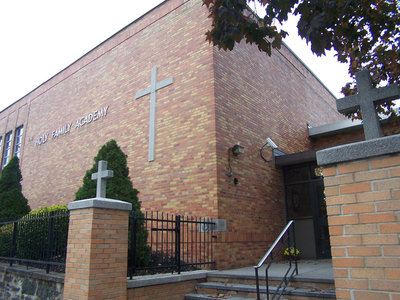Considering that two years ago Holy Family Academy was told it would have to close its doors in June 2009, every day it remains open is a blessing, and administrators say the most significant progress this year has been the efforts to keep the all girls Catholic high school open for now and for the future.
Early in 2008, the Sisters of St. Joseph, who founded the school in 1925, announced that due to reduced enrollment and continued demands for running, they could no longer afford to run the school. As a result, the school would close at the end of the 2008-2009 school year.
This announcement created an outcry in the community and brought together a diverse group of parents, teachers, administrators, alumni, business leaders, public officials and others in an attempt to find a way to keep the school open.
Late last year, the school’s Board of Trustees negotiated a lease agreement with the Sisters of Saint Joseph to operate the school at its current location.
“We are also dedicated to teaching about life in service to others. Our school is all about becoming future citizens.” – Dr. Karen Fasanella
________
She said a Board of Trustees took over governance of the school, and is made up of alumni as well as friends of Holy Family. “Some of those on the board have no direct connection to the school except that they are committed to a single gender Catholic education.”
She said this is like starting a business, and fortunately, the people assembled to help the school survive come from a variety of backgrounds, each bringing a different kind of wisdom to the effort.
“We’re all pulling together, and it is a great success story,” she said.
Fasanella said hard work on various levels made all the difference. Not only did the school get financial and spiritual support, it also received a large human response. However, she said the challenge now is to make sure the school continues to operate, and this will require the same level of dedication.
This is a very active board, too, she said. The board does a lot of the hands-on work to make up for the fact that the school doesn’t have a large staff.
“The biggest challenges through this year have been to convince the public that this has to be something more than for one year, that we are open and we are going to continue to be open in the future,” she said.
This, of course, means an active registration effort.
“I was able to send out 102 acceptance letters,” she said. “This will probably mean we’ll have 40 new freshmen in the fall.”
The change of administration in the state also gives Holy Family Academy hope since the new proposed commissioner of education, Bret Schundler, is a proponent of a voucher system that could help make it financially less burdensome for parents to choose parochial and other non-public schools.
“Our funding comes from tuitions,” Fasanella said. “This means that people who are paying real estate have to pay on top of their taxes to send their children here. Any help at all from the state can make a difference for us, even if it is a property tax credit to those parents.”
She believes that many people would send their girls to Holy Family if not for the $7,500 yearly tuition, partly because the small school not only provides a good education, but offers a kind of community larger public schools can’t provide.
“We are also dedicated to teaching about life in service to others,” she said. “Our school is all about becoming future citizens.”
It is this sense of community that brings back alumni in droves.
Fasanella said the school this year did not make a lot of changes in programs since the administration wanted to make the transition of management as smooth as possible.
One of the key pieces to the educational process at HFA, however, is something called four by four block scheduling, which Fasanella said will allow students to do more advanced course work.
Under normal scheduling, students would take six, maybe even seven, subjects a semester. Under the four by four system, students take four courses from September to January, and four different classes from January to June.
“This allows students to concentrate more on a discipline they may be interested in, and to master the subject better than if they had to take six or seven subjects,” she said.
The four by four program may also have the benefit of freeing seniors during their spring semester for possible internships or a senior project, something Fasanella said the school is hoping to implement by the spring of 2011.
The integrity of the school may well be measured by the number of scholarships seniors receive. So far, the 49 seniors expected to graduate this year have received more than $7 million in grants and scholarships, with more coming in every day, she said.
This being the first year, administrators have begun evaluating its programs with educational committee meetings with school administrators, focusing on keeping an eye on the future.
“We’re looking at summer programs we might be able to offer,” Fasanella said.
Called a Higher Achievement Program, the program would offer full day sessions for five weeks, which focus on core curriculum endeavors, such as enrichment activities.
“It is geared to girls going into eighth grade,” Fasanella said.
